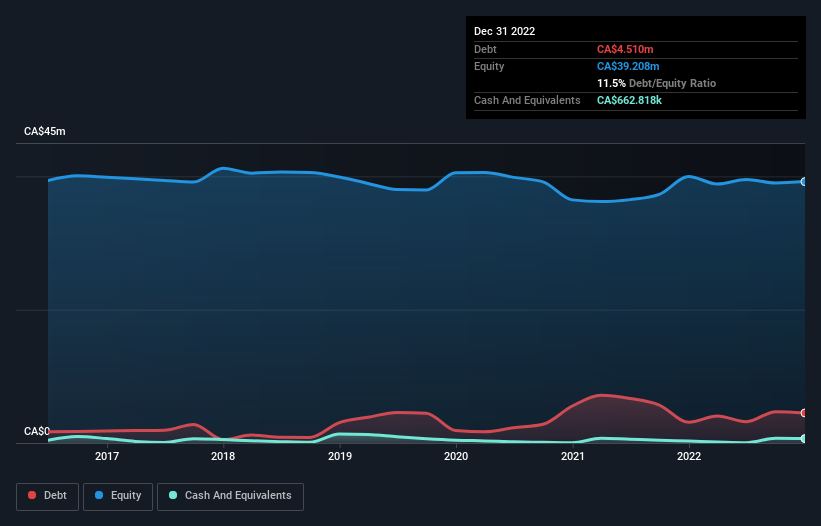Howard Marks put it nicely when he said that, rather than worrying about share price volatility, 'The possibility of permanent loss is the risk I worry about... and every practical investor I know worries about.' So it seems the smart money knows that debt - which is usually involved in bankruptcies - is a very important factor, when you assess how risky a company is. We can see that Oceanic Iron Ore Corp. (CVE:FEO) does use debt in its business. But the real question is whether this debt is making the company risky.
When Is Debt A Problem?
Generally speaking, debt only becomes a real problem when a company can't easily pay it off, either by raising capital or with its own cash flow. If things get really bad, the lenders can take control of the business. However, a more common (but still painful) scenario is that it has to raise new equity capital at a low price, thus permanently diluting shareholders. Having said that, the most common situation is where a company manages its debt reasonably well - and to its own advantage. When we examine debt levels, we first consider both cash and debt levels, together.
Check out our latest analysis for Oceanic Iron Ore
What Is Oceanic Iron Ore's Debt?
You can click the graphic below for the historical numbers, but it shows that as of December 2022 Oceanic Iron Ore had CA$4.51m of debt, an increase on CA$3.10m, over one year. However, because it has a cash reserve of CA$662.8k, its net debt is less, at about CA$3.85m.

How Healthy Is Oceanic Iron Ore's Balance Sheet?
According to the last reported balance sheet, Oceanic Iron Ore had liabilities of CA$1.79m due within 12 months, and liabilities of CA$3.86m due beyond 12 months. On the other hand, it had cash of CA$662.8k and CA$5.9k worth of receivables due within a year. So its liabilities total CA$4.98m more than the combination of its cash and short-term receivables.
While this might seem like a lot, it is not so bad since Oceanic Iron Ore has a market capitalization of CA$9.73m, and so it could probably strengthen its balance sheet by raising capital if it needed to. But we definitely want to keep our eyes open to indications that its debt is bringing too much risk. There's no doubt that we learn most about debt from the balance sheet. But it is Oceanic Iron Ore's earnings that will influence how the balance sheet holds up in the future. So if you're keen to discover more about its earnings, it might be worth checking out this graph of its long term earnings trend.
Given its lack of meaningful operating revenue, investors are probably hoping that Oceanic Iron Ore finds some valuable resources, before it runs out of money.
Caveat Emptor
Importantly, Oceanic Iron Ore had an earnings before interest and tax (EBIT) loss over the last year. Indeed, it lost CA$557k at the EBIT level. Considering that alongside the liabilities mentioned above does not give us much confidence that company should be using so much debt. Quite frankly we think the balance sheet is far from match-fit, although it could be improved with time. Another cause for caution is that is bled CA$682k in negative free cash flow over the last twelve months. So suffice it to say we consider the stock very risky. The balance sheet is clearly the area to focus on when you are analysing debt. But ultimately, every company can contain risks that exist outside of the balance sheet. Be aware that Oceanic Iron Ore is showing 4 warning signs in our investment analysis , and 3 of those don't sit too well with us...
If you're interested in investing in businesses that can grow profits without the burden of debt, then check out this free list of growing businesses that have net cash on the balance sheet.
New: AI Stock Screener & Alerts
Our new AI Stock Screener scans the market every day to uncover opportunities.
• Dividend Powerhouses (3%+ Yield)
• Undervalued Small Caps with Insider Buying
• High growth Tech and AI Companies
Or build your own from over 50 metrics.
Have feedback on this article? Concerned about the content? Get in touch with us directly. Alternatively, email editorial-team (at) simplywallst.com.
This article by Simply Wall St is general in nature. We provide commentary based on historical data and analyst forecasts only using an unbiased methodology and our articles are not intended to be financial advice. It does not constitute a recommendation to buy or sell any stock, and does not take account of your objectives, or your financial situation. We aim to bring you long-term focused analysis driven by fundamental data. Note that our analysis may not factor in the latest price-sensitive company announcements or qualitative material. Simply Wall St has no position in any stocks mentioned.
About TSXV:FEO
Oceanic Iron Ore
An exploration stage company, engages in the acquisition and exploration of iron ore properties in Québec, Canada.
Medium-low risk with imperfect balance sheet.
Market Insights
Community Narratives


Recently Updated Narratives

Astor Enerji will surge with a fair value of $140.43 in the next 3 years

Proximus: The State-Backed Backup Plan with 7% Gross Yield and 15% Currency Upside.

CEO: We are winners in the long term in the AI world
Popular Narratives


MicroVision will explode future revenue by 380.37% with a vision towards success


The company that turned a verb into a global necessity and basically runs the modern internet, digital ads, smartphones, maps, and AI.



